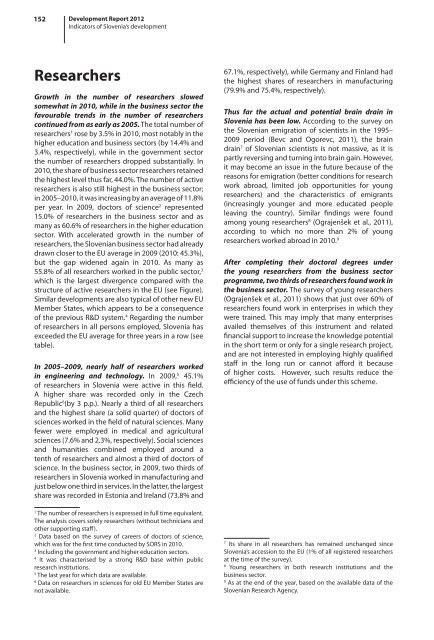development report 2012 - UMAR
development report 2012 - UMAR
development report 2012 - UMAR
You also want an ePaper? Increase the reach of your titles
YUMPU automatically turns print PDFs into web optimized ePapers that Google loves.
152 Development Report <strong>2012</strong><br />
Indicators of Slovenia’s <strong>development</strong><br />
Researchers<br />
Growth in the number of researchers slowed<br />
somewhat in 2010, while in the business sector the<br />
favourable trends in the number of researchers<br />
continued from as early as 2005. The total number of<br />
researchers 1 rose by 3.5% in 2010, most notably in the<br />
higher education and business sectors (by 14.4% and<br />
3.4%, respectively), while in the government sector<br />
the number of researchers dropped substantially. In<br />
2010, the share of business sector researchers retained<br />
the highest level thus far, 44.0%. The number of active<br />
researchers is also still highest in the business sector;<br />
in 2005–2010, it was increasing by an average of 11.8%<br />
per year. In 2009, doctors of science 2 represented<br />
15.0% of researchers in the business sector and as<br />
many as 60.6% of researchers in the higher education<br />
sector. With accelerated growth in the number of<br />
researchers, the Slovenian business sector had already<br />
drawn closer to the EU average in 2009 (2010: 45.3%),<br />
but the gap widened again in 2010. As many as<br />
55.8% of all researchers worked in the public sector, 3<br />
which is the largest divergence compared with the<br />
structure of active researchers in the EU (see Figure).<br />
Similar <strong>development</strong>s are also typical of other new EU<br />
Member States, which appears to be a consequence<br />
of the previous R&D system. 4 Regarding the number<br />
of researchers in all persons employed, Slovenia has<br />
exceeded the EU average for three years in a row (see<br />
table).<br />
In 2005–2009, nearly half of researchers worked<br />
in engineering and technology. In 2009, 5 45.1%<br />
of researchers in Slovenia were active in this field.<br />
A higher share was recorded only in the Czech<br />
Republic 6 (by 3 p.p.). Nearly a third of all researchers<br />
and the highest share (a solid quarter) of doctors of<br />
sciences worked in the field of natural sciences. Many<br />
fewer were employed in medical and agricultural<br />
sciences (7.6% and 2.3%, respectively). Social sciences<br />
and humanities combined employed around a<br />
tenth of researchers and almost a third of doctors of<br />
science. In the business sector, in 2009, two thirds of<br />
researchers in Slovenia worked in manufacturing and<br />
just below one third in services. In the latter, the largest<br />
share was recorded in Estonia and Ireland (73.8% and<br />
1<br />
The number of researchers is expressed in full time equivalent.<br />
The analysis covers solely researchers (without technicians and<br />
other supporting staff).<br />
2<br />
Data based on the survey of careers of doctors of science,<br />
which was for the first time conducted by SORS in 2010.<br />
3<br />
Including the government and higher education sectors.<br />
4<br />
It was characterised by a strong R&D base within public<br />
research institutions.<br />
5<br />
The last year for which data are available.<br />
6<br />
Data on researchers in sciences for old EU Member States are<br />
not available.<br />
67.1%, respectively), while Germany and Finland had<br />
the highest shares of researchers in manufacturing<br />
(79.9% and 75.4%, respectively).<br />
Thus far the actual and potential brain drain in<br />
Slovenia has been low. According to the survey on<br />
the Slovenian emigration of scientists in the 1995–<br />
2009 period (Bevc and Ogorevc, 2011), the brain<br />
drain 7 of Slovenian scientists is not massive, as it is<br />
partly reversing and turning into brain gain. However,<br />
it may become an issue in the future because of the<br />
reasons for emigration (better conditions for research<br />
work abroad, limited job opportunities for young<br />
researchers) and the characteristics of emigrants<br />
(increasingly younger and more educated people<br />
leaving the country). Similar findings were found<br />
among young researchers 8 (Ograjenšek et al., 2011),<br />
according to which no more than 2% of young<br />
researchers worked abroad in 2010. 9<br />
After completing their doctoral degrees under<br />
the young researchers from the business sector<br />
programme, two thirds of researchers found work in<br />
the business sector. The survey of young researchers<br />
(Ograjenšek et al., 2011) shows that just over 60% of<br />
researchers found work in enterprises in which they<br />
were trained. This may imply that many enterprises<br />
availed themselves of this instrument and related<br />
financial support to increase the knowledge potential<br />
in the short term or only for a single research project,<br />
and are not interested in employing highly qualified<br />
staff in the long run or cannot afford it because<br />
of higher costs. However, such results reduce the<br />
efficiency of the use of funds under this scheme.<br />
7<br />
Its share in all researchers has remained unchanged since<br />
Slovenia’s accession to the EU (1% of all registered researchers<br />
at the time of the survey).<br />
8<br />
Young researchers in both research institutions and the<br />
business sector.<br />
9<br />
As at the end of the year, based on the available data of the<br />
Slovenian Research Agency.
















